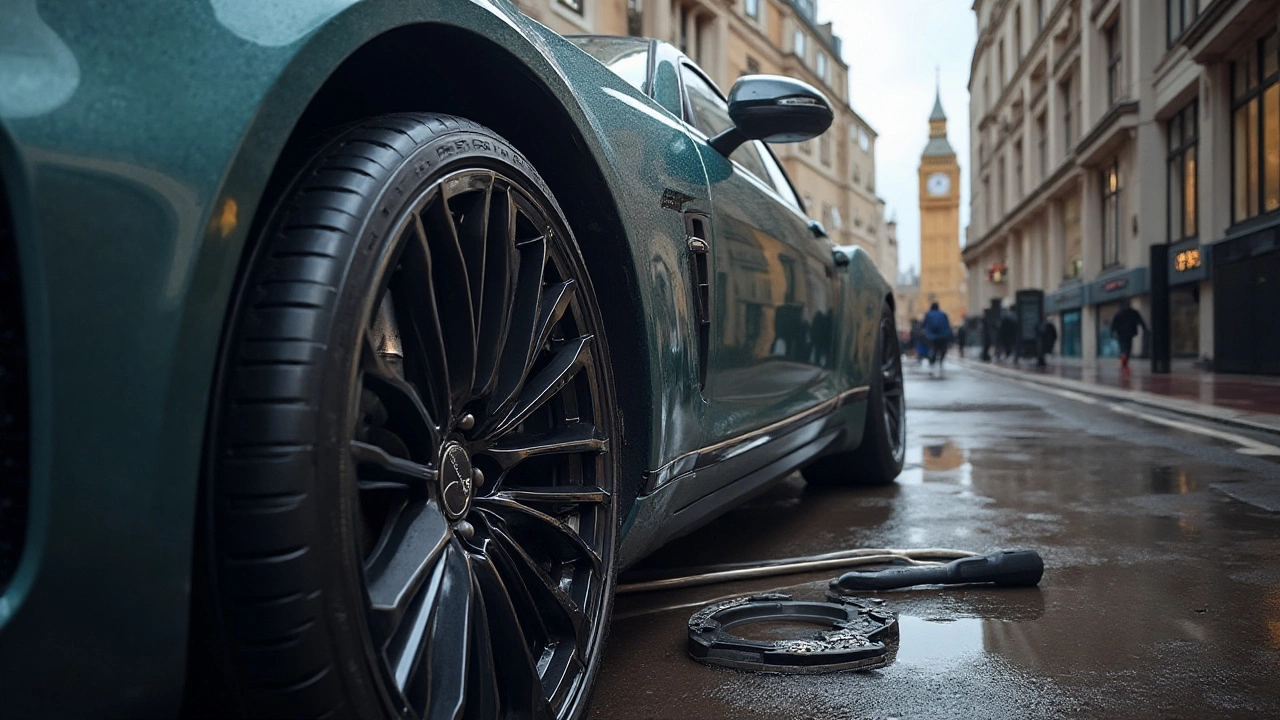Wheel spacers are a popular modification for car enthusiasts looking to enhance the aesthetics and stance of their vehicle. But with every modification comes the inevitable question—does this change require a wheel alignment? It's a thought that isn't just about aesthetics, as proper alignment directly impacts your driving experience.
In this article, we'll explore the intriguing world of wheel spacers and dissect whether an alignment is something you should be considering. From understanding the role of these components to knowing the signs when an alignment is essential, we'll cover all the bases to keep your ride smooth and safe. Let's dive in and unravel what this means for your beloved vehicle.
- Introduction to Wheel Spacers
- How Wheel Spacers Affect Alignment
- When Alignment is Necessary
- Tips for Proper Installation
- Maintaining Alignment and Performance
Introduction to Wheel Spacers
Wheel spacers have long been more than just aesthetic enhancements for vehicles; they are key components in modifying both the appearance and functionality of a car. At their core, wheel spacers are devices that sit between the wheel and the hub of a vehicle, pushing the wheels out further from the suspension. This seemingly simple adjustment can dramatically alter the visual impact of a car, offering a wider stance that is often associated with high-performance vehicles and a more aggressive look.
While the cosmetic appeal is undeniable, the technical benefits of using wheel spacers can be significant as well. By increasing the track width, spacers can potentially enhance stability, particularly through corners, as it distributes the car's weight over a broader area. This can also affect how the vehicle handles stress during driving, especially at higher speeds or in challenging road conditions. However, the benefits don't stop there. Some car enthusiasts turn to spacers to solve clearance issues, effectively creating room for larger, more robust brake systems or exotic wheels that might not fit within standard dimensions.
Despite these benefits, there are important considerations to take into account when opting for a spacer installation. The material and build quality of the spacers are paramount, as low-grade components can lead to dangerous driving issues. Aluminum spacers are a popular choice due to their balance of strength and lightweight properties. An improper installation or poor-quality spacers can lead to vibrations, or worse, compromise the wheel's connection, resulting in catastrophic failures that no driver wants to encounter.
Wheel spacers also impact the vehicle's alignment, a factor that can affect tire wear and the overall driving experience. This raises a crucial question for many: should you get an alignment check after installing wheel spacers? "While not always mandatory," notes automotive expert Alex Johnson in an article for Car Performance Weekly, "realigning your wheels post-installation can ensure optimal wear and tear management and that the enhanced effects of your spacers are realized without compromise."
As you consider this modification, understanding the balance between aesthetics and mechanical impact is essential. Spacers are not universal; their fit and the subsequent effect they may have on alignment and suspension can vary greatly depending on the make and model of the car. Knowing the right size and thickness ensures the modification works harmoniously with your vehicle's design. Whether you're looking to stun onlookers with a new, bold stance or iron out some logistical challenges related to wheel fitment, wheel spacers could be the game-changer you're seeking.
How Wheel Spacers Affect Alignment
Understanding how wheel spacers impact alignment is crucial for any car owner considering this modification. These components work like thin washers that fit between the wheel and the hub, pushing the wheel outwards. This leads to a broader track, which can enhance stability and improve handling, particularly during sharp turns. But what about the ripple effects on alignment? Simply put, wheel spacers can alter the geometry of your suspension system, potentially affecting the alignment angles - camber, toe, and caster.
The camber angle, which is the tilt of the tire when viewed from the front, may change subtly with spacers. A misaligned camber could lead to uneven tire wear, reducing tire life and affecting vehicle handling. You might notice the tires wearing more on one side if the camber is significantly impacted. The toe, which refers to how much the tires turn inward or outward when viewed from above, can be affected as well, especially if the spacers are not installed properly. An incorrect toe setting can lead to tire scrub and drag, which diminishes fuel efficiency.
When we talk about the caster angle, which is the tilt of the steering axis, wheel spacers might not have a direct influence. However, any change in the wheelbase could impact the overall feeling of stability in straight-line driving. Reckless installation of spacers can indeed amplify alignment issues that already exist. According to Michael Holmes, an auto mechanic and enthusiast,
"Installing wheel spacers isn't just about slapping them on. It's about understanding how they interact with your car's existing systems."This underscores the importance of ensuring that all alignment angles are checked and adjusted if necessary, post-installation.

When Alignment is Necessary
The installation of wheel spacers often brings up a key question: Do you really need to realign the wheels? The answer isn't always black and white. The necessity of alignment primarily hinges on the type of wheel spacers you're using and the condition of your car maintenance before installation. If your vehicle was already angled perfectly on the road, the spacers might not disturb this harmony, especially when installing hub-centric spacers, which can maintain the wheel's original centro-symmetric orientation without much fuss.
However, if you're opting for larger spacers, there's a heightened chance that your wheels could deviate slightly. This can affect the angle at which your tires meet the road, an aspect known as camber angle. An altered camber can lead to uneven tire wear, impacting not only the longevity of your tires but also your wheel alignment and vehicle's handling. A noticeable pulling to one side while driving is a telltale sign that an alignment check should be on your agenda.
Tips for Proper Installation
When it comes to installing wheel spacers, paying attention to detail can mean the difference between a smooth ride and a potential headache down the line. Before you even think about unscrewing those lug nuts, make sure you have the right size spacers for your vehicle. Each car has specific wheel hub measurements, and it's crucial to ensure a snug fit to maintain vehicle safety and maximize performance.
Start with preparing the tools you'll need, including a torque wrench, a floor jack, and of course, the wheel spacers themselves. Safety first: ensure your vehicle is on a flat, stable surface to prevent any mishaps. Once you've positioned the car and safely jacked it up, remove the wheel to expose the brake hub. It's the perfect opportunity to examine your brakes and suspension components for any signs of wear.
Align the spacer onto the hub, making sure the bolt holes align perfectly. Misalignment here can lead to vibrations and uneven tire wear. Use the existing lug nuts to secure temporary placement of the spacer. Remember, cleanliness is key—any debris between the spacer and the hub can cause imbalance. Experts often emphasize checking the manufacturer’s instructions for specific torque settings. As per a statement by auto expert James May,
“Proper torque is not just an exact science—it’s essential for road safety.”
While some may view locking compounds as unnecessary, using a medium-strength thread lock on your lug nuts can prevent them from loosening over time. Tighten each nut according to a star pattern to evenly distribute pressure, ensuring a consistent hold. This prevents the spacer from shifting under extreme driving conditions. Adjust the wheels back in place carefully and give each step sufficient time and attention to prevent common errors.
Once everything is installed snugly, lower the vehicle slowly and remove the jack. Before hitting the road, double-check—all nuts must be secure, and the wheels should be firmly attached to the spacers. Reassess torque after a few miles of driving, as the metal can settle differently once under pressure.
Lastly, if possible, take your car for alignment checking by professionals to avoid potential misalignment issues. This ensures that any shifts during installation are corrected promptly. A solid understanding and careful installation process make a significant difference in the long-term maintenance of your vehicle featuring wheel spacers.

Maintaining Alignment and Performance
Maintaining a proper wheel alignment is crucial for both the longevity of your tires and the quality of your ride. Once you've installed wheel spacers, keeping an eye on alignment becomes even more important. Even if initial readings are within acceptable limits, the newly adjusted tire stance may show changes over time due to varying road conditions and driving habits. Regular checks, preferably every six months, or immediately after hitting large potholes, are recommended. These routine checks help identify any misalignments early, preventing uneven tire wear and ensuring your car handles as it should. Let’s not forget that proper alignment isn't just about keeping your tires straight—it can also optimize fuel efficiency.
Another aspect of maintaining alignment is understanding the influence of your driving style. Aggressive cornering, hard braking, or frequently driving on uneven terrain can disrupt the current setup. This is especially relevant when wheel spacers are in use, as these conditions might amplify any minor misalignment. For those who constantly push their cars to the limit, alignment checks might need to be more frequent. It's a small price to pay for peace of mind and performance. Embracing a driving style that's a bit more conservative could help maintain that perfect alignment longer.
While ensuring alignment, one can also benefit from a practice known as tire rotation. This involves swapping the tires from one side to the other and front to back periodically. Doing so can help in achieving even wear across all tires, which complements the objective of maintaining proper alignment. Most professionals suggest rotating your tires every 5,000 to 7,000 miles. Incorporating this with your alignment checks can extend the lifespan of your tires and improve your vehicle's performance.
Tackling Common Misconceptions
It's not uncommon for car enthusiasts to have some misconceptions about wheel spacers and their effect on alignment. A popular belief is that simply installing spacers will always necessitate a complete realignment. While spacers do alter the track width, they don't always directly influence alignment angles such as camber, caster, or toe. It's important to consult with a knowledgeable mechanic after installation to evaluate if an alignment is indeed necessary. Afrom automotive expert Mike Allen notes, "The myth that all spacers require immediate alignment is just that—a myth. It depends greatly on the type and thickness of the spacers, along with the vehicle's specific setup."This highlights the importance of professional advice tailored to your specific setup and usage.
Leveraging Technology for Better Results
In today's technologically advanced world, digital alignment systems offer unparalleled precision. These systems provide real-time data and visuals that help technicians make informed adjustments. Investing in a professional alignment service that utilizes structured laser or a digital imaging system can directly impact the longevity of your tires and improve your vehicle's handling characteristics. In some cases, such as when using wide wheel spacers, such precision can be invaluable.| Check | Frequency |
|---|---|
| Visual Inspection | Monthly |
| Tire Pressure | Monthly |
| Full Alignment Check | Semi-annually |
Finally, maintaining alignment is not just the task of a technician—it’s a partnership between you and your vehicle. Ensuring suitable driving conditions, regular checks, and addressing issues immediately all play an invaluable role. With the proper approach, those wheel spacers can continue to give your ride the desired look and feel without compromising performance.




